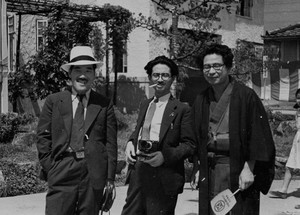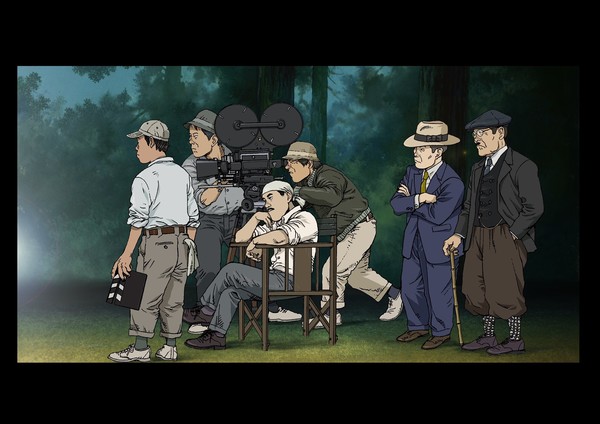How Rintaro's Newest Work Honors Japan's Silent-Film Era
by Alicia Haddick,
Despite his impact on the medium and admiration from his contemporaries for his wit, only three of his films still exist today. His name is somewhat more recognizable to Japanese cinema history buffs; he was an unknown internationally until the first international release of his final work in remastered form, Humanity and Paper Balloons, to much acclaim. On the 85th anniversary of this cinematic pioneer's death, Yamanaka Sadao ni Sasageru Manga Eiga 'Nezumikozō Jirokichi' is Rintarō's return to the anime director's chair with Akira's Katsuhiro Ōtomo and an all-star crew for a unique recreation of one of Yamanaka's lost films.
Another point of context needed to understand Nezumikozo Jirokichi is how Japanese cinema was presented to the general public. While the introduction of sound in The Jazz Singer in 1928 revolutionized Hollywood and quickly ended the silent era, Japan was slower to embrace the talkies because Japanese film had never truly been silent. Benshi narrators would often play the music, read the narration, and give commentary to the films live, bringing a flavor and energy that made these narrators just as much of a star as the actors on screen.

Benshi meant that films showcased, based on the manner of their dialogue delivery or additional comments, could produce a fundamentally unique experience to seeing the same film in another cinema while providing an additional incentive that no amount of spoken word could match. Sure, Japanese theaters screened talkies beginning in 1931, but a quarter of films in Japan relied on benshi as late as 1938, long after the transition had finished in other countries.
Watching Nezumikozo Jirokichi brings this dual history of creator and industry into focus. We start with a look at the man behind the camera prepping the shoot before soon resorting to an abridged retelling of the film in a method that blends Yamanaka's style with benshi narration offered by Mami Koyama and artistic flair only possible in this very 21st-century animation process.
For those unaware, Nezumikozo Jirokichi is a Robin Hood-esque tale of a thief who stole from the rich to give to the poor. He reportedly committed many robberies of affluent homes throughout the Edo period. The real thief has a child who admires their antics while he almost playfully condemns them. A chance encounter with an old flame rekindles the idea of love and brings him out to further commit crimes for the good of the people before hiding into the night. Closing us out, we return to his preparation for another take and a real-life photograph of the man himself.
Distinct character designs provided by Otomo bring life to the story as we witness what is otherwise a faithful benshi-narrated silent film play out before us. The flair comes from the use of dramatic techniques within the otherwise-flat duo-chrome aesthetic reflective of the possibilities of film of the time; a layered cut-out effect on the lamps of law enforcement chasing after the criminal, a bounce across rooftops with effortless ease, a clarity otherwise impossible in unreliable classic film cameras. It's like a dance, the styles of Yamanaka and Rintarō stepping in rhythm and complementing one another to bring the film to life.
Following its world-premiere screening at the Niigata International Animation Film Festival, a post-screening talk event showcased a who's-who of legendary animated talent from across the industry, encompassing all aspects of production from voicing to directing to planning to designs to even the producers and animators. By the end of the talk, director Rintarō, planner Masao Maruyama, narrator Mami Koyama, character designer Katsuhiro Ōtomo, Mamoru Oshii, producers from MIYU and GENCO, and animators from Studio M2 and beyond took to the stage to discuss the work.
Introducing what about the project made him want to return to directing after an extended absence, Rintarō shared his love of jidaigeki cinema as a big reason for his interest in the film while expressing his admiration for Yamanaka's legacy. He referenced how he loved the genre as a kid for its emphasis on visuals and stories told through non-spoken means.
"Young people today won't recall many silent films, but Alfred Hitchcock once said that 'all movies started with silence.' I also think about how creators in this era evolved the medium so much when watching silent films. I wanted to make this film silent, and when using the script from Yamanaka's Edo volume of Nezumikozo Jirokichi, I didn't want to change his drama to a more modern style but instead create something in his style, hence why I included 'dedicated to Sadao Yamanaka' in the main title," explained Rintarō. This meant capturing Yamanaka in the way he was viewed at the time: smoking in his director's chair.
Rintarō expressed a desire to prioritize a creation that is distinctly his interest and work rather than what the industry demands. "[As Japanese animation has evolved, I wondered] what sort of work could I make as I spoke to [planner] Maruyama," as Rintarō put it. "I couldn't make Demon Slayer, so let's make something in my style. Let's go back to the origin of Japanese movies. How about Yamanaka's work? It was from this we started making the storyboards."
Animators and producers from both inside and outside Japan came together for the production. A significant number of European animators worked on the project and assisted on the film, allowing talent from around the world to become involved.
As for recreating the essentially-Japanese curiosity of benshi within the film, Koyama's task required her to step significantly beyond her comfort zone. She was brought into the project thanks to her more mature tone and stature befitting of the role (She joked that it was "quite rude" that she was "asked to play the grandma"), and she liked that it was unlike any challenge she'd attempted before.
"Both Maruyama and I started in the animation industry around the same time, and we worked on a lot of robot anime, so we worked together quite a lot," recalled Koyama. "But I was always the princess in these works. Now I would be the benshi in this work for Rintarō, and I was really surprised! I was wondering, 'Could I do it?' At the time, I'd never seen or performed a benshi before, so I was really unsure. I was really wondering what the best approach was. I thought about it a lot, but I thought about how this wasn't the normal sort of job I'd be offered, which helped convince me to take it."
For this vocal performance, Koyama was heavily assisted by a production process that offered her far more to work from than usual. Unlike many TV anime, they had key animation and many of the visuals prepared by the time they got around to recording the vocal track, which helped her to match the performance to the film like a proper benshi. The focus was on the animation as a silent project, ensuring that the kabuki and varied inspirations of Yamanaka's ‘non-standard’ style were replicated.
The staff involved held a lot of passion and care for the project as titans of the anime industry came together for what is, ultimately, an artistic passion project. The talk was light-hearted, with staff and producers sharing their enjoyment of the project. The talk even took a brief unplanned break for Otomo to personally hand out stickers to the press and fans in the crowd! Even select animators commented on their enjoyment of working on the film. However, their insight was limited partly because, by admission, no animators expected to be invited on stage to speak to the crowd!
Nezumikozo Jirokichi is a project in a niche category, but evidence of the staff's respect for it deserves oozes from every drawing, creating a work that showcases the delicate hands of every name involved. The production is set for release to the general public later this year.
discuss this in the forum (3 posts) |